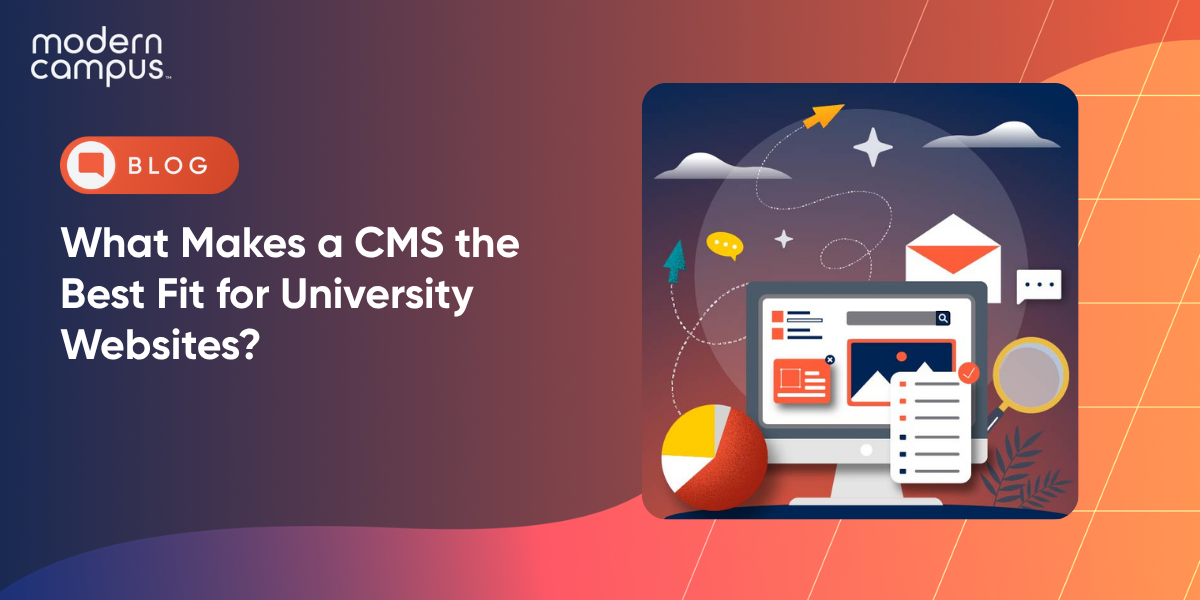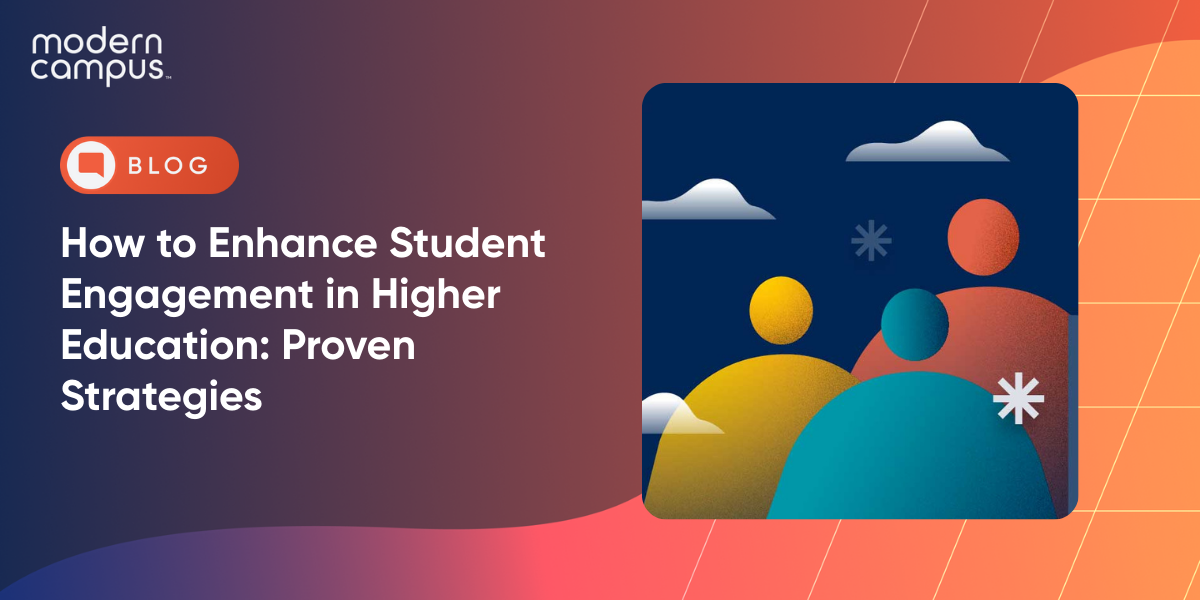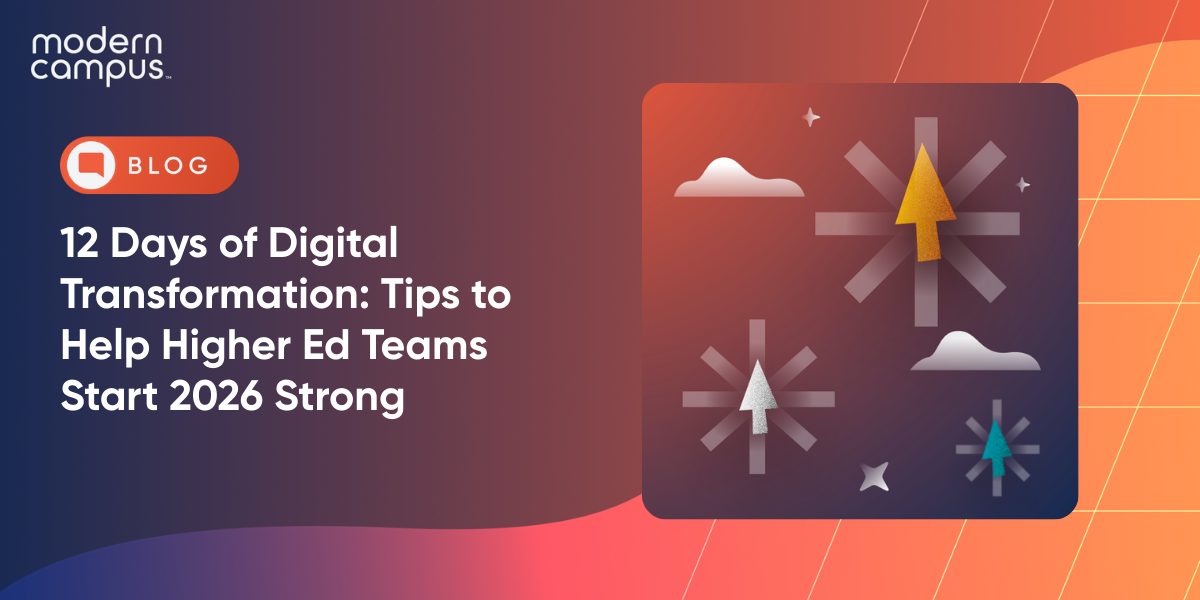What Makes a CMS the Best Fit for University Websites?
Universities require specialized content management systems that go beyond basic website needs. Key factors include:
- Built-in accessibility compliance
- Robust security features
- Higher education-specific tools
- Seamless integration with campus systems
The right CMS transforms operational efficiency while supporting the entire student lifecycle from prospective learners to lifelong alumni.
U.S. universities are facing unprecedented pressures. Undergraduate enrollment has declined, with a 15% drop between 2010 and 2022, while prospective students increasingly question the value of higher education. Meanwhile, ransomware attacks on higher education surged by 70% in 2023, and 96.3% of university websites fail basic accessibility compliance. Against this backdrop, choosing the right CMS for higher education has become absolutely vital for institutional success.
University websites must serve diverse audiences, including prospective students researching programs, current students accessing resources, faculty managing course content, alumni staying connected and community members seeking information. This complexity demands a specialized approach that generic content management systems can't provide.
Why Do Universities Need a Purpose-Built CMS for Higher Education?
While generic content management platforms work well for basic business websites, they fail to meet the unique demands of higher education institutions. Universities operate within a complex ecosystem of regulations, stakeholder needs and operational challenges that require specialized solutions.
Consider the regulatory landscape alone. Universities must comply with FERPA privacy regulations, Section 508 accessibility requirements and state-specific data protection laws. They handle sensitive student information, process financial aid data and manage research materials requiring different security protocols. A retail-focused CMS lacks the built-in safeguards and compliance features essential for these environments.
Stakeholder complexity further underscores why universities need a higher education CMS designed specifically for their needs. A single institution must simultaneously serve:
- Prospective domestic and international students researching programs
- Parents seeking financial aid information
- Current students accessing course materials
- Faculty updating research profiles
- Donors exploring giving opportunities
Each group requires different information architecture, user pathways and functional capabilities.
Universities operate on unique business models that differ from commercial enterprises. They must attract and retain students while supporting their complete educational journey, often spanning decades through alumni relationships. This lifecycle requires content management capabilities that evolve with changing student needs while maintaining institutional continuity.
Essential CMS Features Universities Can’t Afford to Overlook
Universities require sophisticated features that address their specialized operational, legal and stakeholder demands. The following capabilities separate truly effective higher education CMS platforms from generic alternatives. These features enhance functionality and protect institutions from risks while enabling transformational student experiences.
1. Built-in Accessibility Compliance and Enforcement
Web accessibility is legally mandated and ethically essential. With accessibility lawsuits increasing by 14.1% from 2022 to 2023, institutions need proactive protection. The best CMS for universities and colleges should include automated accessibility scanning, WCAG 2.1 compliance checking and enforcement mechanisms that prevent non-compliant content from being published.
Leading systems provide real-time feedback during content creation, alerting editors to missing alt text, improper heading structures or insufficient color contrast before pages go live. This proactive approach saves universities from costly remediation and legal challenges while ensuring equal access for all users.

2. Enterprise-Grade Security with Higher Ed Focus
Cybersecurity threats targeting universities are increasing, with North American institutions reporting a 70% increase in ransomware attacks in 2023. Universities require CMS platforms with robust security frameworks specifically designed for educational environments.
Essential security features include:
- Role-based access controls that align with academic hierarchies
- Integration with campus single sign-on systems
- Automated security updates
- Compliance with FERPA and other educational privacy regulations
- Audit trails for content changes and user activities, crucial for maintaining data integrity and regulatory compliance

3. Seamless Integration with Campus Systems
Universities rely on numerous specialized systems, including student information systems (SIS), learning management systems (LMS), customer relationship management (CRM) platforms and financial aid systems. The ideal campus CMS integrates seamlessly with these existing tools, eliminating data silos and reducing administrative burden.
This integration enables dynamic content updates, such as automatically pulling course information from the SIS into web catalogs, synchronizing event data across multiple platforms and maintaining consistent student records across touchpoints. Such connectivity ensures accuracy while reducing manual data entry and associated errors.
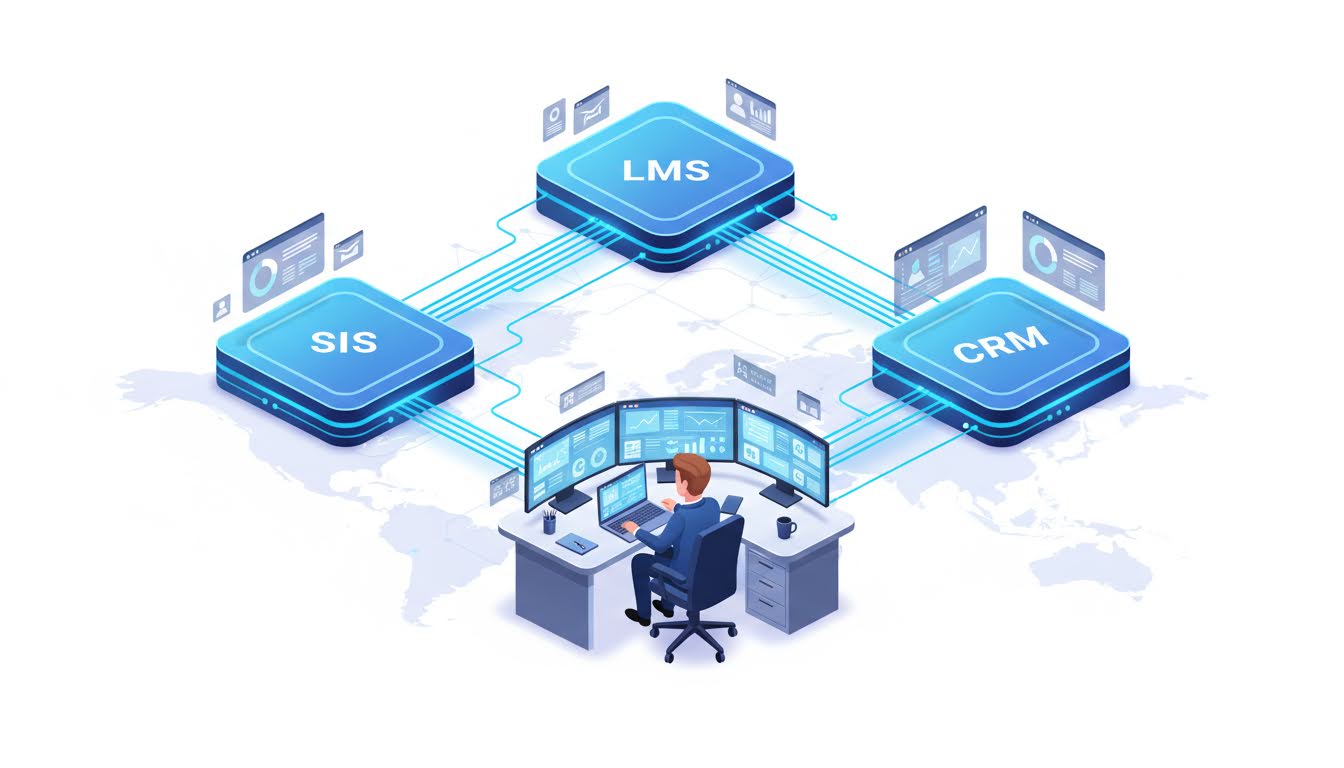
4. Multi-Site Management Capabilities
Large universities often manage hundreds of websites across different departments, colleges, programs and research centers. The best CMS for universities provides centralized governance with decentralized content management, giving departments autonomy while maintaining brand consistency and compliance standards.
These systems enable:
- Template standardization
- Centralized user management
- Automated updates across multiple sites
- Consistent analytics reporting
IT teams can push security updates universally while allowing individual departments to manage their specific content needs.
5. Advanced Content Workflow and Approval Systems
University content often requires multiple levels of review before publication, especially for sensitive topics like admissions requirements, financial aid policies or research announcements. Sophisticated workflow capabilities ensure proper approvals while maintaining publishing timelines.
The system should support customizable approval chains, automated notifications, version control with rollback capabilities and deadline management. These features prevent publishing errors while ensuring content accuracy and institutional voice consistency.
6. Mobile-First Design and Performance Optimization
With students and families increasingly researching universities on mobile devices, responsive design is a must. However, a CMS for higher education needs to go beyond basic responsiveness to include performance optimization for various network conditions and device capabilities.
To effectively reach prospective students regardless of their technical constraints, platforms must:
- Automatically optimize images
- Provide progressive loading
- Support offline access to critical information
- Ensure fast load times even with complex content structures
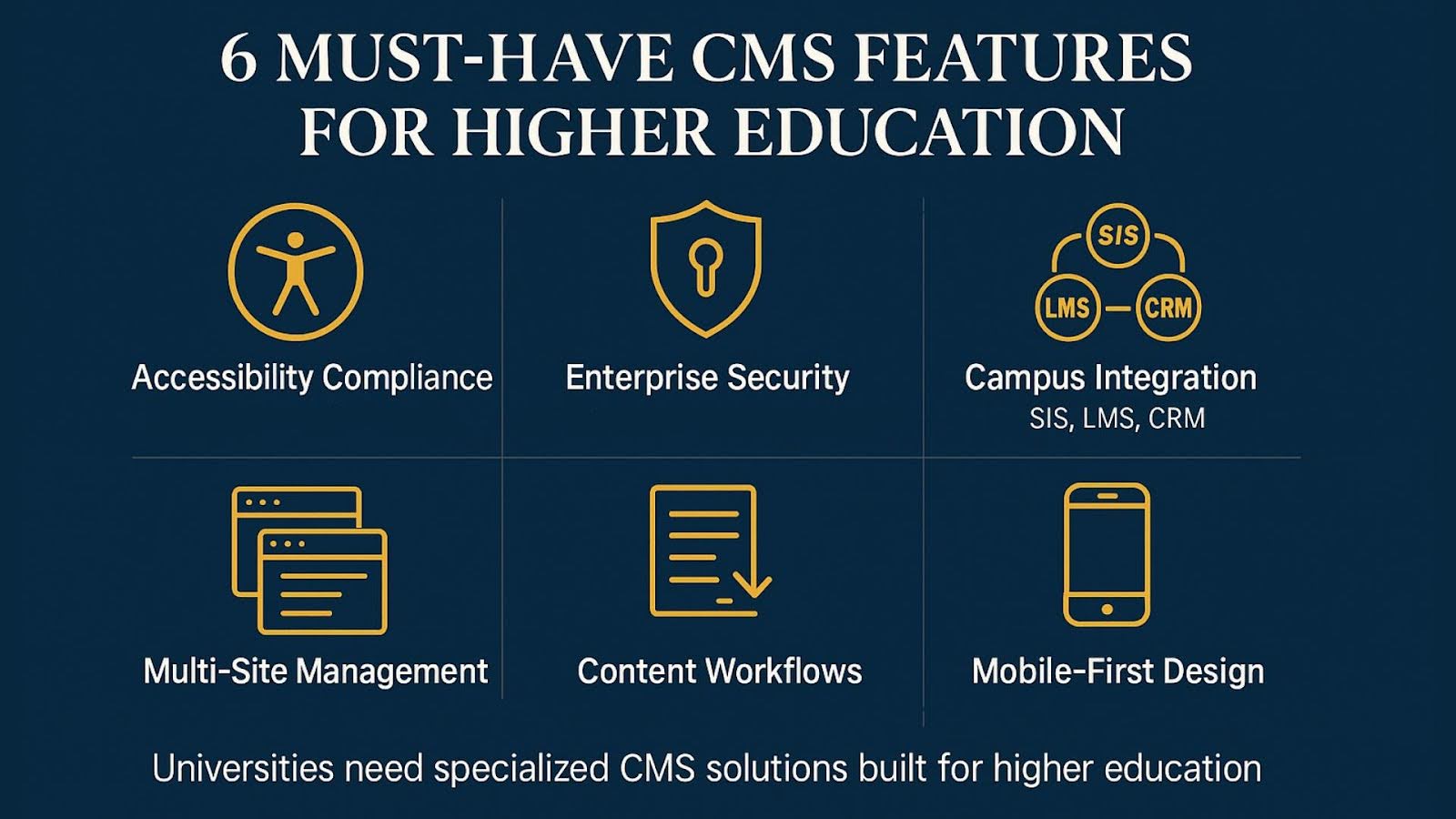
How Does the Right CMS Transform University Operations?
When universities implement purpose-built content management systems, the operational improvements surpass website management. These transformations directly impact institutional effectiveness and student outcomes.
Administrative Efficiency Gains
The right higher education CMS reduces administrative overhead through automation and integration. Tasks that previously required IT intervention, such as course catalog updates, event calendar management or faculty directory maintenance, become self-service capabilities for department staff. This shift frees IT resources for strategic initiatives while empowering content creators with immediate publishing capabilities.
As a result, institutions see a decrease in routine website maintenance tasks, allowing staff to focus on student engagement or digital marketing campaigns. The efficiency gains compound over time as staff become proficient with intuitive tools designed for their specific workflows.
Enhanced Student Experience Through Personalization
Modern university CMS platforms enable sophisticated personalization that guides students through an educational journey that looks like this:
- Prospective students get customized program recommendations based on their interests and academic background.
- Current students access personalized dashboards showing relevant courses, deadlines and campus activities.
- Alumni receive targeted content about continuing education opportunities and giving campaigns.
Personalization transforms static institutional websites into dynamic engagement platforms that adapt to individual user needs and preferences, improving both satisfaction and conversion rates.
Improved Compliance and Risk Management
Purpose-built systems include compliance monitoring and risk mitigation features:
- Automated accessibility scanning that prevents violations before they occur
- Content archiving and version control that supports regulatory requirements
- Integration with campus systems that ensures data consistency across platforms
These capabilities reduce institutional liability while providing documentation necessary for audits and compliance reporting. Universities can demonstrate proactive accessibility efforts, maintain proper data governance and respond quickly to any compliance concerns.
What Should Universities Prioritize When Selecting a CMS?
Selecting the right CMS for higher education requires balancing immediate needs with long-term institutional goals. The most successful implementations consider technical capabilities and organizational readiness.
Technical Infrastructure Assessment
Universities should first evaluate their existing infrastructure and staff capabilities. Consider current hosting arrangements, integration requirements, security protocols and maintenance capacity. The chosen system must align with existing IT resources while providing growth flexibility.
Equally important is assessing content creation workflows and staff technical skills. Low-code CMS platforms can empower non-technical staff while reducing dependence on specialized developers. This consideration is vital for universities with limited IT resources or distributed content management responsibilities.
Total Cost of Ownership Evaluation
Beyond initial licensing costs, universities must consider long-term ownership expenses, including hosting, maintenance, training and ongoing support. Purpose-built higher education systems often provide better value through included services, automatic updates and specialized support teams familiar with institutional needs.
The evaluation should include potential cost savings from improved efficiency, reduced compliance risks and enhanced student engagement. These benefits often offset higher upfront costs through operational improvements and risk mitigation.
Vendor Partnership and Support Quality
Higher education operates on unique timelines and faces specific challenges that generic CMS vendors may not understand. Look for solutions with demonstrated higher education expertise, comprehensive training programs and ongoing professional development resources.
The ideal partnership includes guidance on best practices for higher education websites, industry trend insights and peer learning opportunities through user communities.
Scalability and Future-Proofing
Universities must consider both growth capacity and evolving requirements when selecting CMS platforms. The system should accommodate increasing content volumes, expanding user bases and emerging technologies without requiring complete replacements.
Future-proofing includes API flexibility for new integrations, mobile capability expansion, accessibility standard evolution and emerging compliance requirements. The chosen platform should adapt to changes in higher education rather than constraining institutional innovation.
Frequently Asked Questions
What's the difference between a regular CMS and one designed for higher education?
Higher education CMS platforms include specialized features like built-in accessibility compliance, academic calendar integration, course catalog management and student lifecycle tools. They also provide enhanced security protocols for handling sensitive educational data and FERPA compliance requirements that generic systems lack.
How important is accessibility compliance for university websites?
Accessibility compliance is legally mandatory and ethically essential. Universities face significant legal and financial risks from non-compliance, with accessibility lawsuits increasing annually. Beyond legal requirements, accessible websites serve the diverse needs of students, faculty and community members with disabilities.
Can universities use open-source CMS platforms like WordPress or Drupal?
While some universities successfully use open-source platforms, they require extensive customization and ongoing maintenance to meet higher education needs. Purpose-built systems provide essential features out of the box, reducing implementation time and long-term maintenance burden while ensuring compliance and integration capabilities.
What integration capabilities are most important for university CMS platforms?
Critical integrations include student information systems (SIS), learning management systems (LMS), customer relationship management (CRM) platforms and campus authentication systems. These integrations eliminate data silos, improve user experience and reduce administrative overhead while maintaining data accuracy across platforms.
Choosing Your University's Digital Foundation
The right CMS choice shapes every aspect of your institution's digital presence and operational efficiency. While generic platforms may seem appealing due to familiarity or lower initial costs, they often create long-term challenges through compliance gaps, integration limitations and feature deficiencies.
Universities need partners who understand the unique challenges of higher education, from evolving accessibility requirements to complex stakeholder needs to integration demands. The investment in a purpose-built CMS for higher education pays dividends through improved operational efficiency, enhanced student experience and reduced institutional risk.
Modern Campus offers comprehensive solutions built exclusively for colleges and universities, backed by decades of expertise and a deep understanding of institutional needs. Discover how the right CMS can revolutionize your university's operations and create exceptional experiences for all your stakeholders.
Last updated: October 23, 2025
